Arabic Chopped Salad (Salata Arabieh)
This easy Arabic chopped salad is fresh and zesty. Serve it as part of a mezze spread, stuff it into warm pita pockets with fresh falafel, or use it to lighten a heavy meal. It goes with everything!
This Arab salad goes by many names. Salata arabieh, salata mafrumeh, salata na’ameh, salata baladi (Egyptian salad), or salata fallahi (Persian salad) to name a few. But whether you call it an Israeli salad, a Lebanese salad or a Palestinian salad, it’s the same chopped fresh vegetables that make up this delicious Arabic chopped salad.
Understandably, it’s the most popular Middle Eastern salad.
And, while it’s salad perfection already, it’s also a blank canvas. Tweak the salad recipe to fit your mood and what you have around the house. Keep reading for some suggestions, or jump straight to the easy Arabic salad recipe.
The salad recipe is adapted from the “Chopped salad: Three ways” recipe in Falastin by Sami Tamimi and Tara Wigley.
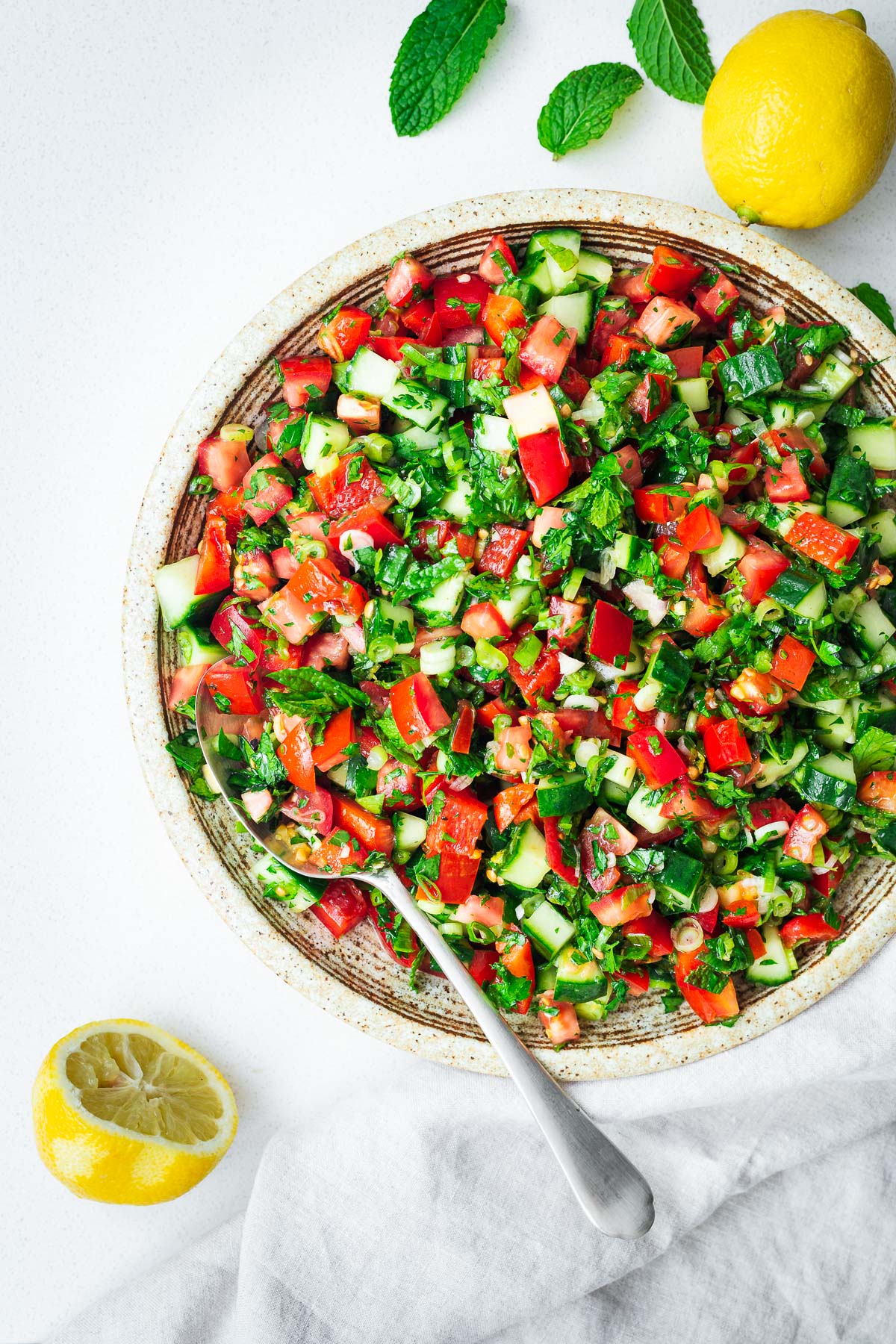
Ingredients & substitutes
As with any simple recipe, use only the freshest ingredients. There is nowhere to hide in this simple salad. Look for perfectly plump and juicy tomatoes, crunchy cucumbers and fresh herbs.
The salad requires lots of chopping, so grab your sharpest knife to slice your vegetables into small pieces.
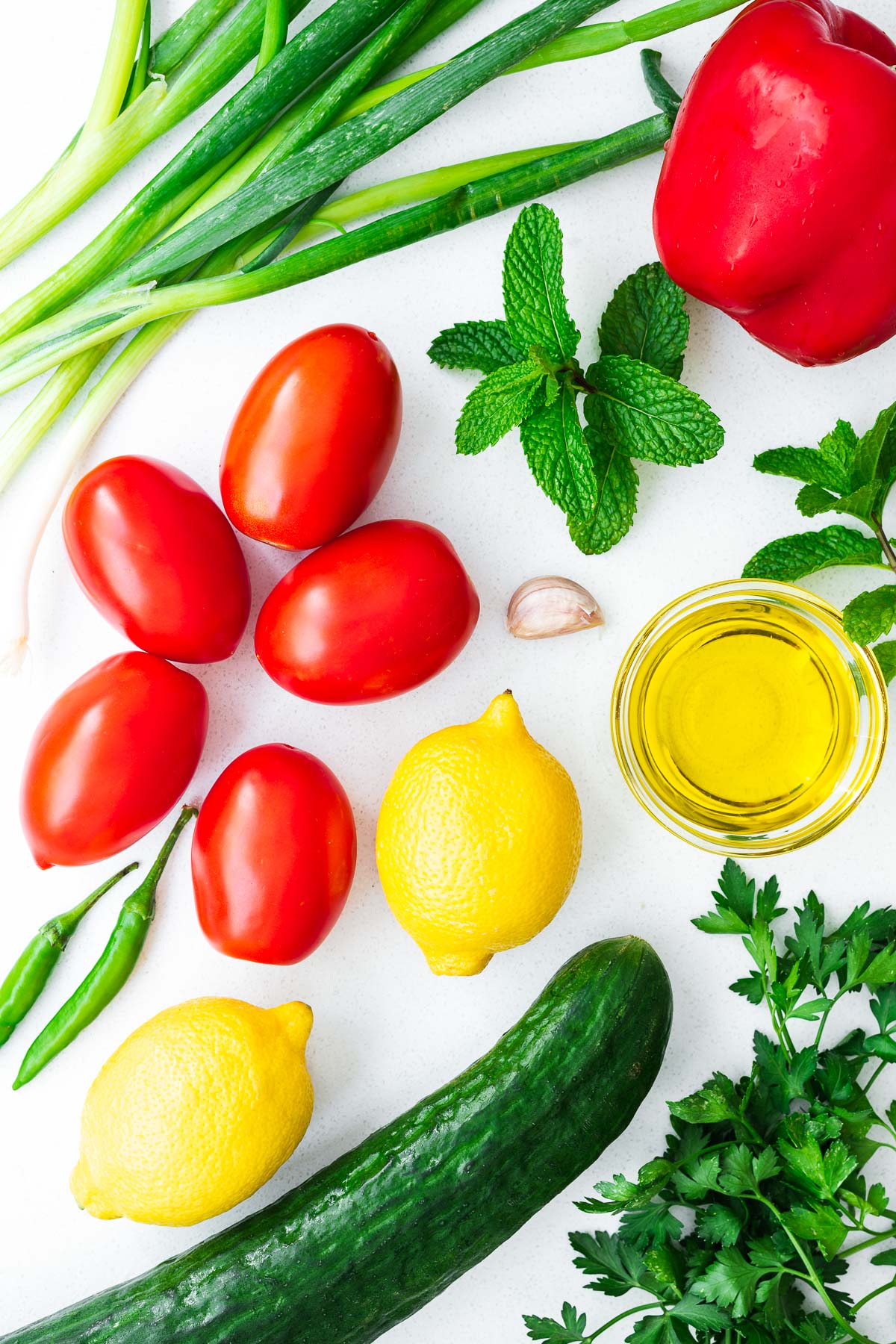
Classic Arabic salad ingredients
- Cucumbers: You can use English cucumbers or the smaller Persian cucumbers, as long as they are fresh and crunchy.
- Tomatoes: Roma tomatoes are widely available. I use them in many Middle Eastern salad recipes, but you can use sweet vine tomatoes, like cherry tomatoes, or regular tomatoes.
- Red Pepper: I prefer red bell pepper for the visual appeal and sweet flavour, but you can use green bell pepper or another sweet pepper.
- Onions: The recipe calls for finely sliced spring onions (or green onions). Or try finely diced red onion or shallots for a delicious variation.
- Chillies: They are optional, but I love the subtle heat of two medium-hot green chillies. You can use red chillies or omit the chillies in favour of a spicy condiment on the side. Try shatta sauce or zhoug.
- Olive oil: Don’t skimp on the olive oil. Use good quality extra virgin olive oil.
- Parsley: What would a Middle Eastern salad be without a healthy dose of fresh parsley? I don’t recommend skipping the parsley. It is an essential ingredient in any good Arabic salad. But if you really don’t enjoy it, you can omit it in favour of more fresh mint or chopped cilantro (coriander).
- Mint: Sheared fresh mint leaves turn this into one of the most refreshing salads out there. But you can swap it for more parsley, or a tablespoon of dry mint.
- Garlic: A small fresh garlic clove, minced or finely chopped, is all you need. I’m all in for substituting ingredients in recipes, but this is not the place for shop-bought processed garlic. Rather omit it if you are in no mood to mince garlic.
- Lemons: A good dose of lemon juice and zest balances this perfect salad.
While I may appear a tad prescriptive with the main ingredients listed above, there is always room for improvisation.
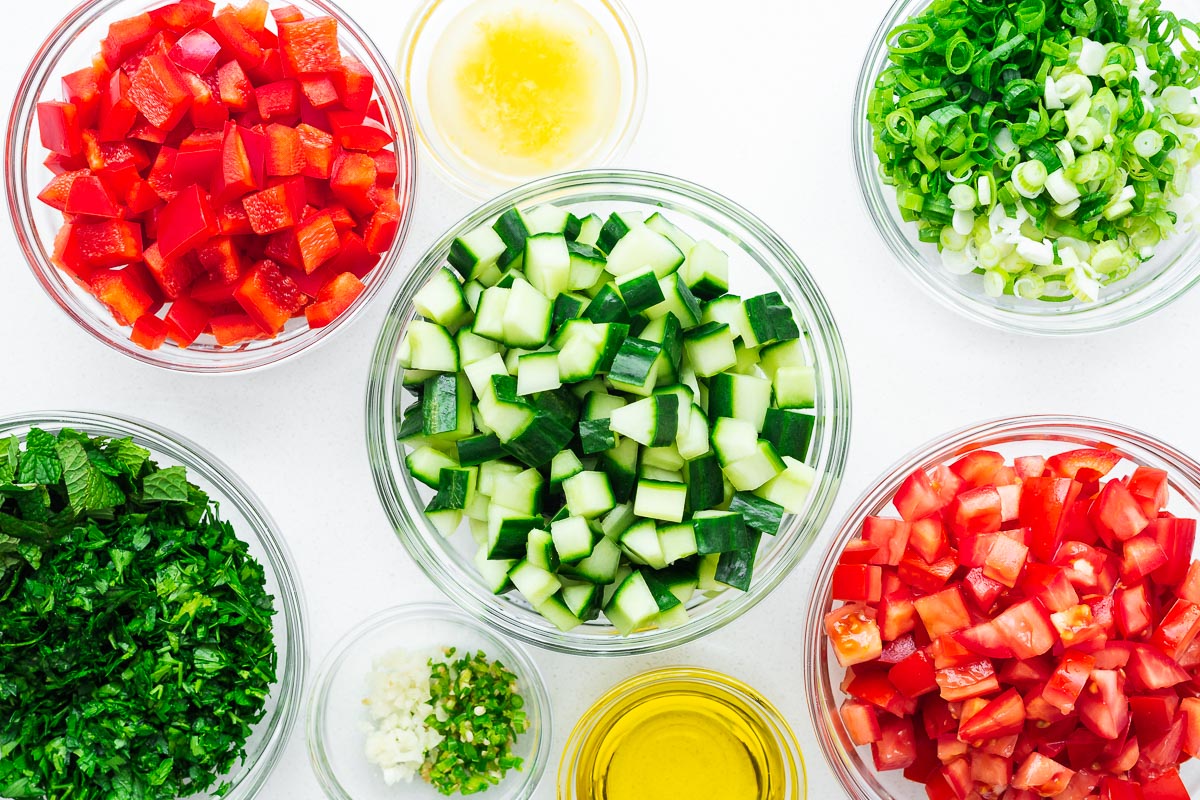
Optional add-ins
- Feta cheese: Crumble cow, goat, sheep or vegan feta over the chopped vegetables.
- Black olives: Destone black olives and roughly chop the flesh to mix into the salad.
- Za’atar: Any Middle Eastern salad recipe welcomes a sprinkling of za’atar. Or sprinkle it with sumac or ground black lime.
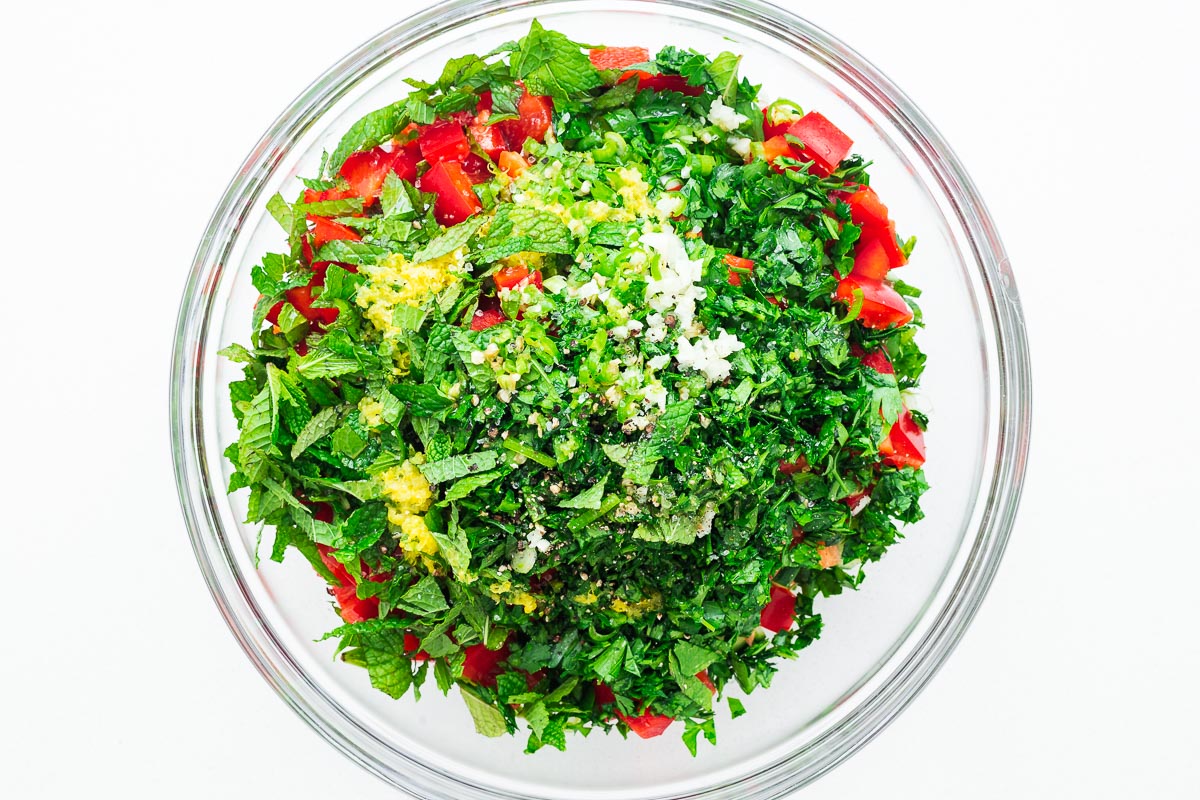
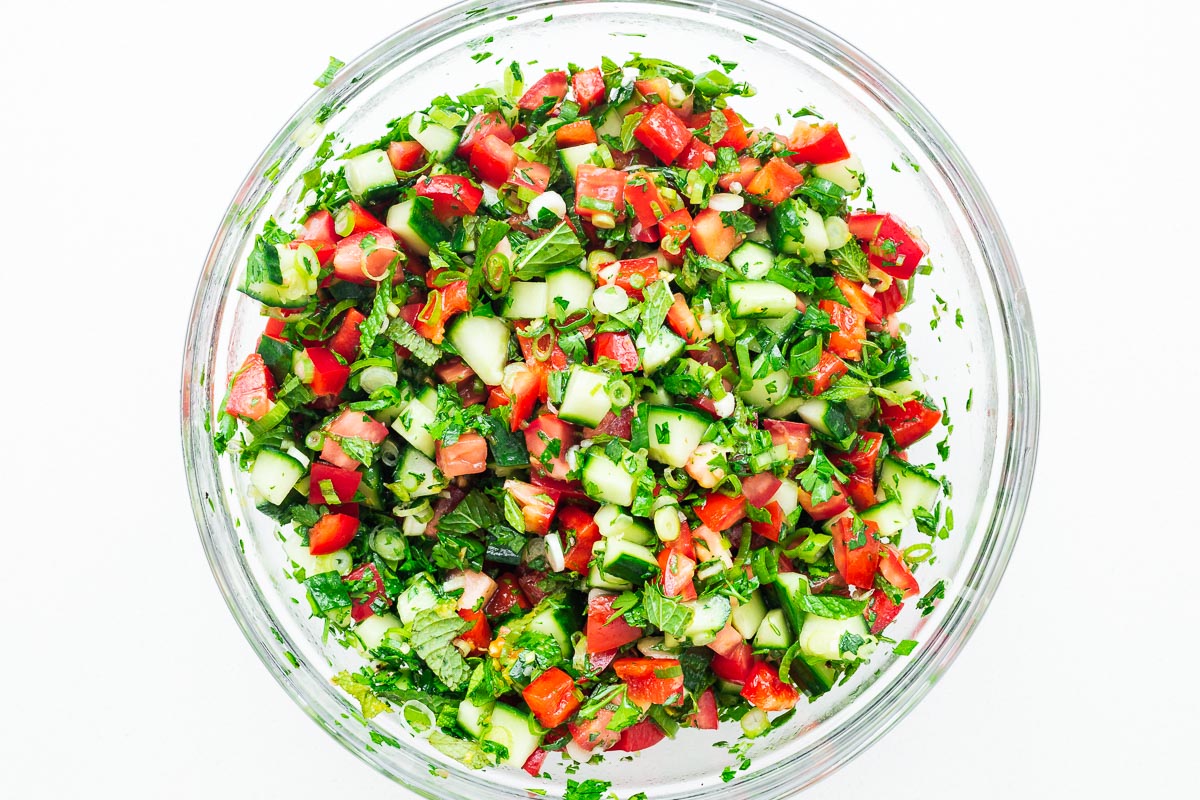
The best salad dressing for Arabic salad
Don’t get me wrong – this simple salad needs no boost. It sings of fresh herbs and citrusy goodness. It’s one of those situations where the dish is greater than the sum of its humble ingredients.
But if you were to serve this salad with a dressing, you can’t go wrong with tahini or yoghurt-based salad dressings.
Drizzle the salad with two tablespoons of salted tahini and sprinkle with sumac powder or za’atar. Or serve the fresh salad with this maple tahini dressing or green tahini herb sauce on the side.
Why not try a mint yoghurt dressing? Stir the shredded fresh mint leaves, lemon juice and zest from the recipe, with a teaspoon of dried mint, into half a cup of Greek-style yoghurt. Season it to taste with salt and black pepper.
This black lime yoghurt dressing is fabulous if you want something new and exciting.
How to serve Arabic chopped salad
This simple salad is compulsory with any mezze spread, even for breakfast.
For a Persian brunch spread, serve the chopped salad with an oven-baked kuku sabzi (Persian herb frittata), mast-o khiar (Persian yoghurt with cucumber and rose petals), and easy yoghurt flatbread.
Stuff it into warm toasted pita bread with crispy Middle Eastern falafel (or baked falafel) and creamy hummus or green tahini sauce. Serve your falafel pita with spicy Middle Eastern sauce like shatta sauce or zhoug.
Or serve it as a side dish to lighten Middle Eastern meat dishes, rice dishes or hearty stews, like this Persian aubergine stew with black limes. And add some mast-o khiar (Persian cucumber yoghurt sauce) and easy yoghurt flatbread.
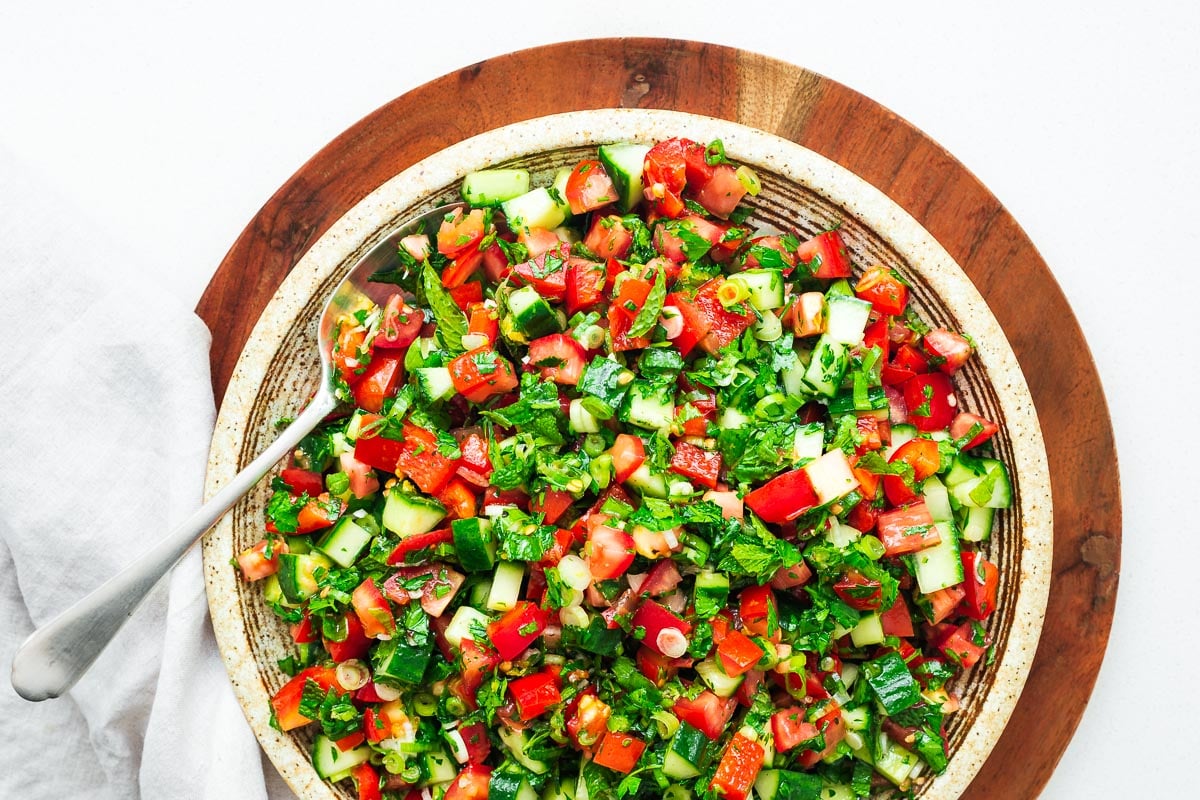
This perfect chopped salad works well beyond Arabic food.
It is fresh salad perfection.
Crunchy cucumbers, fresh tomatoes, sweet red peppers and fresh lemon juice go with just about any meal.
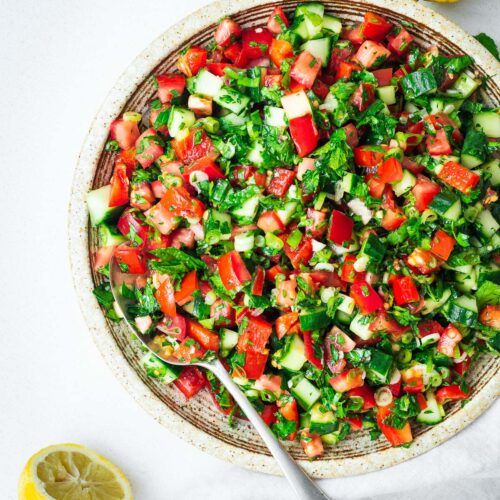
Ingredients
- 5 ripe medium-sized Roma tomatoes, cut into ½ inch (1 cm) dice
- 1 English cucumber or 3 Lebanese cucumbers, quartered lengthways, seeds removed and cut into ½ inch (1 cm) dice
- 1 red bell pepper, cored and deveined, cut into ½ inch(1 cm) dice
- 5 spring onions or green onions, white and green parts finely sliced
- 2 green chillies (optional), deseeded and finely chopped
- 3 tablespoons olive oil
- 1 cup finely chopped flat-leaf parsley
- ½ cup shredded mint leaves
- 1 garlic clove, minced
- 2 lemons, finely grated for 2 tablespoons of zest and juiced for 3 tablespoons
- salt and black pepper
Instructions
- Drain the chopped tomatoes and place them in a large bowl.
- Add the rest of the ingredients with a teaspoon of salt and a good grind of black pepper.
- Mix well and taste. Season it with more salt (I add another ½ teaspoon) and black pepper to taste.
Notes
- See the ingredients section for substitute ideas and add-ons.
- This Arab salad is best when fresh. But you can store any leftover salad in an airtight container and refrigerate it for up to 3 days. Luckily, there won’t be any soggy salad leaves, but water from the tomatoes and cucumber will accumulate in the container. Pour off the water and serve the leftover salad with fresh lemon juice and new olive oil.
- The Arabic chopped salad recipe is adapted from the basic “Chopped salad: Three ways” recipe in Falastin by Sami Tamimi and Tara Wigley.
In the mood for salad? Why not try another Middle Eastern-style salad recipes:

I tried this recipe in June 2024. The flavors of this salad were amazing. I ate this over several days and it only got better by the time I finished it. I will be making this again.
I’m so happy you loved this salad as much as I do, Sue! And, thank you so much for taking the time to leave your review. ☺️
great Israeli salad
Thanks, Akbar! It’s one of my all-time favourite salads. So refreshing, goes with everything, and I always have the ingredients.
This easy Arabic salad was so delicious!
I’m so happy you enjoyed it! It’s one of my favourites too.
This is my favorite salad too! It’s so deliciously fresh and zingy, it goes with any meal.
I know, right? It’s such a versatile salad.